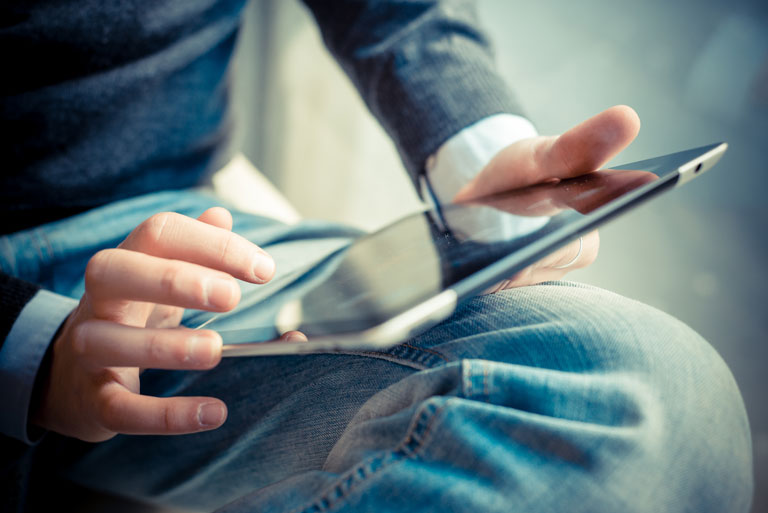
Inexpensive teleprompter solution with iPad, Galaxy or other tablet and passive teleprompter
5 components for perfect video recording with teleprompter and tablet
Most definitely, technology is not what determines the success or quality of a video – because the content has to be right, of course.
But: Bad technology can devalue even the best content. Whether it’s sales or training videos: Noise and crackling, poor lighting, a distracted presenter or presenter… all contribute to looking unprofessional and credibility suffers.
To make sure this doesn’t happen to you, I’ve put together the technique I use myself here. Some things don’t have to be expensive, but for some things you’d better not skimp. This includes above all the quality of the sound, which in my experience is more important than the image itself.
So here’s “my” technique, which I’ve used to produce over 200 videos so far. Good luck!
1. the teleprompter
As teleprompter we use a “device” from TeleprompterPad. I write the word “device” in quotation marks because it is not actually a device, but rather a device, a passive teleprompter. is and consists essentially of a sheet of glass, some sheet metal and fabric.
I use a normal iPad as the playback device for my slides. I mirror the PowerPoint presentation beforehand with PPT Mirror, creating a PDF file. I also have PowerPoint on my iPad, but find it more convenient to work with a PDF file because I can play that back in iBooks, for example.
You can buy the Teleprompter for 10 inch tablets (e.g. the iPad Standard) here at Amazon, the one for 13″ tablets is available at this link.
Note: The links on this page are affiliate links from Amazon, which means that if you follow them and order the products from Amazon, we will receive a small commission, which also helps to improve our software.
2. the camera
A good camera is important, although it can be said today that even the simplest smartphones take excellent pictures. Almost more important than the camera, however, is the sound, because the information in a video is conveyed not by the image of the speaker, but by what he or she says. So you have to be understood well, background noise should be avoided as much as possible. Therefore, it is important that a camera has a port for an external microphone.
I use the Sony RX10 M3 camera. This produces an excellent image, has an HDMI output for a control monitor (I use a normal monitor, but then turn it off during recording). Above all, however, an input for an external microphone. The camera can also be mounted on a standard tripod and fits into the above-mentioned teleprompter. For sound and a suitable microphone you will find some hints below.
Recording tip: A neutral, white background is best so your viewers can watch the video without distractions. But then the camera darkens because of the large white area, the background becomes rather gray and the subject in the foreground a bit too dark. I therefore set the exposure compensation to “+0.75” (i.e. three quarters of a stop brighter than the automatic determined). This makes the shot a bit brighter exposed, the subject (me) is thus properly illuminated and the background is also white again (instead of gray).
3. the right lighting
The quality of a video recording depends very much on even, balanced lighting. Therefore, you should use artificial light to avoid cast shadows, over- or underexposure, and fluctuations in brightness during shooting.
A “softbox” provides even illumination of the face; you should set up a lamp a little further so that contours in the face can be seen. Two of these lights are enough to make an appealing video of a person talking. In addition, you can order, among other things, spotlights for the backlight.
Link to product: https://amzn.to/2sWmO9m
4. it’s the tone that counts
Almost more important than the image is the sound – because what do you want your viewers to “take away”? The images usually emphasize what you are saying or what is being said. And with a bad sound, it’s no fun listening to you – viewers will click away. Therefore, I strongly recommend working with an external microphone and not “across the room” with the camera’s built-in microphone.
If you film with your smartphone (iPhone, Samsung Galaxy), you are well served with the Rode SmartLav clip-on microphone well served. This is a cheap but high quality microphone. You can use an extension cable for this if you are standing further away and save the expensive radio microphone system.
To operate a “normal” camera (e.g. video camera) with the Rode microphone, this extension cable is recommended, which also includes the conversion to a normal, three-pin jack plug. The Rode microphone has a four-pin plug and is therefore compatible with smartphones (which normally work with a headphone/microphone combination). This cable puts the signal on a normal three-pin connector as used in common cameras.
The more expensive profile equipment
Those who want to dig a little deeper into their pockets are well served by a wireless microphone system from Sennheiser. Starting at about 500 euros, you can get a wireless set consisting of a transmitter and receiver and a lapel microphone. We use the Sennheiser EW 122 set.
Andyes, there are also cheaper microphones. After a while, you realize that background noise, hissing or crackling are annoying and you pay twice – this is a hint from my own experience.
Tip: The closer a microphone is to the speaker, the better. This makes any background noise quieter in relation to the voice and avoids “reverberation”. The voice sounds clear and natural and does not sound tinny. A clip-on microphone is therefore the second-best solution in terms of sound quality. A headset or neckband microphone would be the best, but is not as “nice” because of the look of the microphone in front of the mouth.
5. remote control
Advance slides during video recording? Quite simple: with a foot switch.
A Bluetooth foot switch can be easily paired with the tablet and allows you to switch to the next slide yourself during your recording. After a little practice (yes, you should practice using it), this will throw you off less than having a third party operate the prompter. You then switch over when you have grasped the slide content and can already prepare yourself mentally for the next slide.
The Bluetooth foot switch I linked here is actually for musicians (e.g. violinists) who digitally turn over their sheet music on the tablet. Therefore, the keys are particularly quiet and do not disturb the recording, e.g. by cracking.
Alternatively you can simply use a Bluetooth remote control remote control. I use a remote control from Saatechi because it’s very small and handy, so it’s hardly noticeable when you switch to the next slide. A little cheaper and made of plastic is this model. Both work; I use the remote control for outdoor shots, and the foot switch for indoor shots.

Ralf Armbrüster
CEO intellicon GmbH




